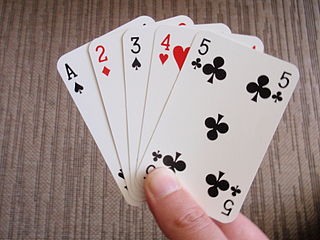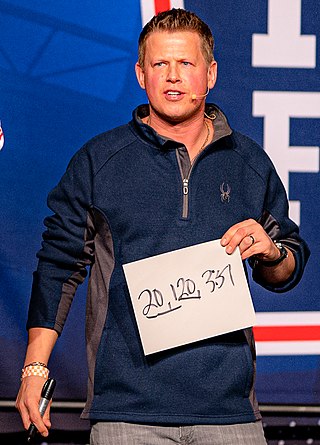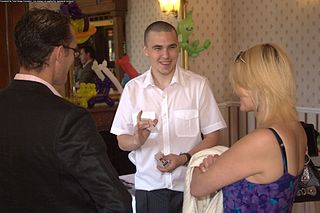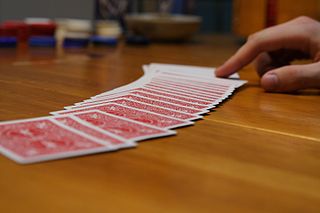
A playing card is a piece of specially prepared card stock, heavy paper, thin cardboard, plastic-coated paper, cotton-paper blend, or thin plastic that is marked with distinguishing motifs. Often the front (face) and back of each card has a finish to make handling easier. They are most commonly used for playing card games, and are also used in magic tricks, cardistry, card throwing, and card houses; cards may also be collected. Playing cards are typically palm-sized for convenient handling, and usually are sold together in a set as a deck of cards or pack of cards.

Shuffling is a procedure used to randomize a deck of playing cards to provide an element of chance in card games. Shuffling is often followed by a cut, to help ensure that the shuffler has not manipulated the outcome.

The Magician (I), also known as The Magus or The Juggler, is the first trump or Major Arcana card in most traditional tarot decks. It is used in game playing and divination; in the English-speaking world, the divination meaning is much better known.
Sleight of hand refers to fine motor skills when used by performing artists in different art forms to entertain or manipulate. It is closely associated with close-up magic, card magic, card flourishing and stealing. Because of its heavy use and practice by magicians, sleight of hand is often confused as a branch of magic; however, it is a separate genre of entertainment and many artists practice sleight of hand as an independent skill. Sleight of hand pioneers with worldwide acclaim include Dan and Dave, Ricky Jay, Derek DelGaudio, David Copperfield, Yann Frisch, Norbert Ferré, Dai Vernon, Cardini, Tony Slydini, Helder Guimarães and Tom Mullica.

Richard Jay Potash was an American stage magician, actor and writer. In a 1993 profile for The New Yorker, Mark Singer called Jay "perhaps the most gifted sleight of hand artist alive". In addition to sleight of hand, he was known for his card tricks, card throwing, memory feats, and stage patter. He also wrote extensively on magic and its history. His acting credits included the films The Prestige, The Spanish Prisoner, Mystery Men, Heist, Boogie Nights, Tomorrow Never Dies, Heartbreakers, State and Main, House of Games and Magnolia, and the HBO series Deadwood. In 2015 he was the subject of an episode of PBS's American Masters, the only magician ever profiled in the series.

Card manipulation is the branch of magic that deals with creating effects using sleight of hand techniques involving playing cards. Card manipulation is often used in magical performances, especially in close-up, parlor, and street magic. Some of the most recognized names in this field include Dai Vernon, Tony Slydini, Ed Marlo, S.W. Erdnase, Richard Turner, John Scarne, Ricky Jay and René Lavand. Before becoming world-famous for his escapes, Houdini billed himself as "The King of Cards". Among the more well-known card tricks relying on card manipulation are Ambitious Card, and Three-card Monte, a common street hustle also known as Find the Lady.

The Yu-Gi-Oh! Trading Card Game is a collectible card game developed and published by Konami. It is based on the fictional game of Duel Monsters created by manga artist Kazuki Takahashi, which appears in portions of the manga franchise Yu-Gi-Oh! and is the central plot device throughout its various anime adaptations and spinoff series.
A trick deck is a deck of playing cards that has been altered in some way to allow magicians to perform certain card tricks where sleight of hand would be too difficult or impractical.

Rick Smith Jr. is a professional illusionist and card thrower from Cleveland, Ohio. Having derived his throwing skills from his time as an NCAA Division I pitcher at Cleveland State University, Smith currently holds three world records: farthest throw of a playing card, highest throw of a playing card, and most playing cards consecutively thrown into a horizontal target. Smith has released a number of instructional films on card throwing and magic.

Alexander Herrmann was a French magician, better known as Herrmann the Great. He was married to magician Adelaide Herrmann, known as the Queen of Magic.
This is a glossary of conjuring terms used by magicians.

Joshua Jay is an American magician, author, and lecturer. He has performed in over 100 countries and was awarded top prize at the World Magic Seminar in 1998. He worked with Penn and Teller on the show Fool Us, and he holds a Guinness World Record for card tricks. Jay has performed on shows including Good Morning America and The Today Show. In January 2018, Jay was recognized by the Society of American Magicians for his contribution to the art of magic.

Close-up magic is magic performed in an intimate setting usually no more than 3 meters from one's audience and is usually performed while sitting at a table.

Magic, which encompasses the subgenres of illusion, stage magic, and close-up magic, among others, is a performing art in which audiences are entertained by tricks, effects, or illusions of seemingly impossible feats, using natural means. It is to be distinguished from paranormal magic which are effects claimed to be created through supernatural means. It is one of the oldest performing arts in the world.
Chris Linn is an American magician, comedian, and entertainer.

In stage magic, a force is a method of controlling a choice made by a spectator during a trick. Some forces are performed physically using sleight of hand, such as a trick where a spectator appears to select a random card from a deck but is instead handed a known card by the magician. Other forces use equivocation to create the illusion of a free decision in a situation where all choices lead to the same outcome.

Throwing is a physical action which consists of mechanically accelerating a projectile and then releasing it into a ballistic trajectory, usually with the aim of impacting a distant target. This action typically refers to hand-throwing by animals with prehensile forelimbs. In this case, the projectile is grasped in a hand while the proximal limb segments move through compounded kinematic chains to impart a mechanical advantaged swinging motion. For other animals, the definition of throwing is somewhat unclear, as other actions such as spitting or spraying may or may not be included.
The Living Playing Cards is a 1905 French silent trick film directed by Georges Méliès.
The Rising Card is a popular category of magical illusion in which the magician causes randomly selected playing cards to spontaneously rise from the center of a deck. Many variations of this trick exist and are performed widely. The effect can be accomplished using a variety of methods and techniques, ranging from pure sleight of hand to complex electronic and mechanical solutions.

















